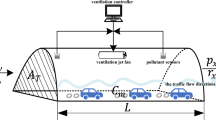Abstract
In order to protect cleanrooms from contamination from adjacent less clean spaces, the cleanroom must be built air tight and maintain an (over) pressure of sufficient magnitude and deviation. For this magnitude there are guidelines. However, there is a lack of guidelines for the required deviation of the pressure. As a result, an unstable pressure could result in an undefined air direction and increase the risk of contamination. This unstable pressure occurs especially during entering the cleanroom with an air tight cleanroom. In this paper the pressure and the entrance of the cleanroom are modeled in the SimuLink modeling environment. The model is verified and validated. The main problem addressed here is that the air tightness and the deviation of the pressure are in conflict with each other. It is concluded that the new proposed adjustment decreases the deviation of the pressure in the cleanroom and enhances the precision of control.
Similar content being viewed by others
References
Chen J, Lan C, Jeng M, Xu T (2007). The development of fan filter unit with flow rate feedback control in a cleanroom. Building and Environment, 42: 3556–3561.
GMP (2003). Manufacture of Sterile Medicinal Products, EC Guide to Good Manufacturing Practice, Revision to Annex 1, Ad Hoc GMP Inspections Services Group, Belgium.
Hu S, Wu J, Chan D, Hsu R, Lee J (2008). Power consumption benchmark for a semiconductor cleanroom facility system. Energy and Buildings, 40: 1765–1770.
IEST-RP-CC006-2 (2001). Testing Cleanrooms, Institute of Environmental Sciences and Technology, USA.
ISO 14644-1 (1999). Cleanrooms and associated controlled environments — Part 1: Classification of air cleanliness. International Organization of Standardization, Switzerland.
ISO 14644-2 (2000). Cleanrooms and associated controlled environments — Part 2 Specifications for testing and monitoring to prove continued compliance with ISO 14644-1. International Organization of Standardization, Switzerland.
ISO 14644-3 (2005). Cleanrooms and associated controlled environments — Part 3: Test methods. International Organization of Standardization, Switzerland.
ISO 14644-4 (2001). Cleanrooms and associated controlled environments — Part 4: Design, construction and start-up. International Organization of Standardization, Switzerland.
Kircher K, Shi X, Patil S, Zhang KM (2010). Cleanroom energy efficiency strategies: Modeling and simulation. Energy and Buildings, 42: 282–289.
Lin T, Tung Y, Hu S, Chen Y (2011). Experimental study on airflow characteristics and temperature distribution in non-unidirectional cleanrooms for electronic industry. Building and Environment, 46: 1235–1242.
Noh K-C, Oh M-D, Lee S-C (2005). A numerical study on airflow and dynamic cross-contamination in the super cleanroom for photolithography process. Building and Environment, 40: 1431–1440.
Saidi MH, Sajadi B, Molaeimanesh GR (2011). The effect of source motion on contaminant distribution in the cleanrooms. Energy and Buildings, 43: 966–970.
Shih H, Huang S, Li S, Chen S, Tsai C (2009). Simulation and testing of pollutant dispersion during preventive maintenance in a cleanroom. Building and Environment, 44: 2319–2326.
Voets AE (1999). Drukhiërarchieën in SKAR. Master thesis, Technical University Eindhoven, The Netherlands. (in Dutch)
Walenkamp GHIM (2005). Beheersplan luchtbehandeling voor de Operatieafdeling. Retrieved from http://www.orthopeden.org/uploads/450/1514/NOV17LB.pdf
Xu T, Lan C, Jeng M (2007). Performance of large fan-filter units for cleanroom applications. Building and Environment, 42: 2299–2304.
Xu T (2008). Characterization of minienvironments in a cleanroom: Assessing energy performance and its implications. Building and Environment, 43: 1545–1552.
Yang S, Fu W (2002). A numerical investigation of effects of a moving operator on airflow patterns in a cleanroom. Building and Environment, 37: 705–712.
Author information
Authors and Affiliations
Corresponding author
Rights and permissions
About this article
Cite this article
van den Brink, A.H.T.M., van Schijndel, A.W.M. Improved control of the pressure in a cleanroom environment. Build. Simul. 5, 61–72 (2012). https://doi.org/10.1007/s12273-012-0065-8
Received:
Revised:
Accepted:
Published:
Issue Date:
DOI: https://doi.org/10.1007/s12273-012-0065-8




